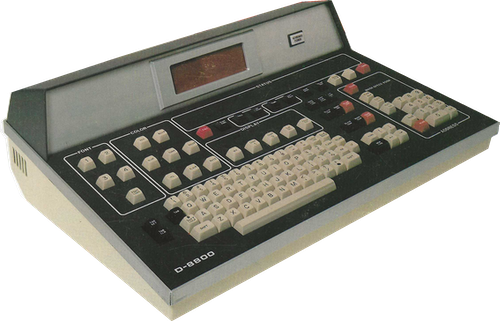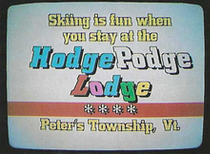3M Datavision D-8000

The 3M Datavision D-8800 was a character generator for the television broadcast industry. It existed circa 1977-1986 and very little information about it exists on the web, outside of mentions in trade journals. There is a Wiki for character generators, but the entry for the D-8800 is mostly empty. A semi-technical marketing presentation can be found here1. A description of the product and its price2 is here3. A comparison of features between various brands of character generators from 1983 is here4. Several ads from the trade journals can be found here5, here6, here7, and here8. An article featuring a D-8800 in a studio is here9. Want ads from 1985 for people with D-8800 experience are here10 and here11. A used D-8800 was offered for sale in October, 1990, here12.
I worked on the software for the D-8800 from circa 1978 to possibly as late as early 1981. Memories fade after 45 years. But I kept the following material among my memorabilia:
- Product brochure
- Font brochure
- More Fonts
- Logo Compose software
- Billboard software
- Camera Compose option
- Computer Interface option
- Real-time Clock software option
The keyboard was a "beast". Not only did it have a QWERTY keyboard, it had a number of buttons for selecting fonts and colors, and for starting various operations such as roll (scroll multiple pages of text up or down) and crawl (scroll a line of text across the screen). There were lights that could be turned on, off, and flashed for operator feedback. There were four seven segment LEDs above the numeric keypad. Files were stored on floppy by number, 0000 (?) to 9999 and the LEDs were used to display that number to the user. There was an LCD screen for user instructions and feedback.
The two computers communicated via DMA. The video system had an interrupt for vertical sync which, if I remember correctly, was the only timer the system had. Because the display CPU had the timer, as well as the need to keep the video system fed in conjunction with vertical sync, it constantly told the system CPU what it needed and when. It would also ask the system CPU if the user had done anything it needed to know about. This caused one of the more interesting problems in my career. The system would lock up, but so rarely that the problem could never be reproduced. After a year and a half I discovered that the DMA register that contained the amount of data to transfer would not have the value that was written to it. So one CPU would wait forever for a transfer to complete. Suds then found that if the system was doing everything all at once that the voltage might drop below nominal levels causing the malfunction in the DMA register. Fixing the problem was easy - the length value would be written, then read back, until what was read matched what was written.

All tech products have a lifecycle. In 1984, 3M announced their BFA system, here13. But this at least was three years after I had moved on.
[1] Excerpted from the 1978 Proceedings of the "31st Annual Broadcasting Conference" of the NAB", pages 30-33.
[2] In all of the years I worked on this product, I never knew how much it sold for. $28,990!
[3] Excerpted from "Video Images, 1982", page 134.
[4] Excerpted from "BroadCast Engineering's Spec Book, December 15, 1983", page 48
[5] Excerpted from "Broadcast Engineering, March, 1977", page 41.
[6] Excerpted from "Broadcast Engineering, January 1979", page 21.
[7] Excerpted from "Broadcast Engineering, March 1981", page 145.
[8] Excerpted from "Broadcast Management/Engineering, October 1983", page 120.
[9] Excerpted from "Broadcast Management/Engineering, December 1985", pages 83-84.
[10] Excerpted from "Broadcasting, April 22, 1985", no page numbers.
[11] Excerpted from "Broadcast Engineering, December 1985", page 128.
[12] Excerpted from "Broadcast Engineering, October 1990", page 117.
[13] Excerpted from "Mix, November 1984", pages 132, 143.

